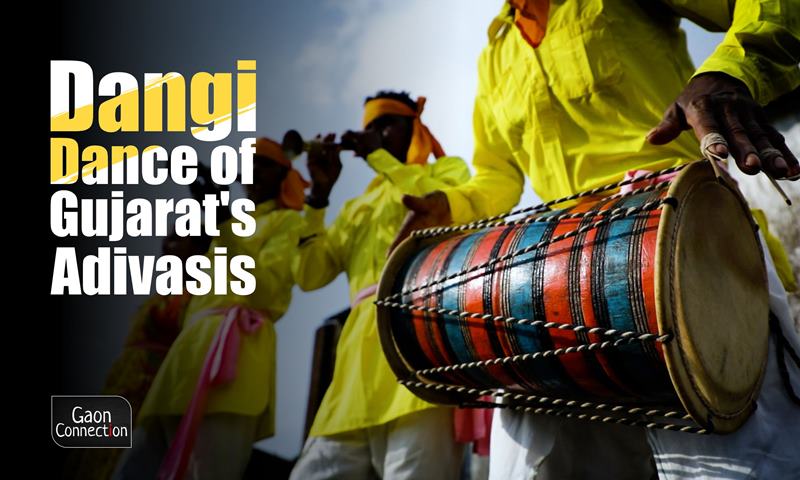Dhavalidaud village (Dang), Gujarat
Like tribal communities elsewhere, the Dangi tribe lives close to the elements amidst the Sahyadiri hills in Dang district in south-east Gujarat. Being part of the Western Ghats, this Adivasi community is surrounded by trees, mountains, waterfalls, streams, birds and beasts.
Dangi Nritya, their joyous dance is their homage to Nature – dharti maata (mother earth) – who, the Adivasis believe, protects and provides for them.
This tribal dance, performed by both men and women, is a sprightly and acrobatic affair filled with energy. Gaon Connection recently travelled to Dang district and attended the performance of Dangi Nritya at Dhavalidaud village in Ahwa taluka.
कभी #गुजरात के डांग जाना तो वहां के आदिवासियों की लोक संस्कृति जरूर देखिएगा, आज आपको यहां का एक ऐसा ही लोक नृत्य दिखा रहे हैं, ढोलक की थाप और शहनाई की धुन पर किए जाने वाले #FolkDance को देखकर आपके भी पैर थिरकने लगेंगे।
— GaonConnection (@GaonConnection) December 6, 2021
वीडियो: @JamwalNidhi @TribalAffairsIn #TribalDance pic.twitter.com/MQw3PSxBv8
Twelve young dancers attired in shades of yellow fanned out in the clearing. An abandoned old shed slumbered in the sun on one side, but there was nothing sleepy about the dancers as they dipped, rose, stepped forward and back in time to the music being provided by three of their companions playing a dholak, and two shehnais.
“The small shehnai is the naari (female), the big one is the nar (male),” Devidas, a village elder from Dhavalidaud village, explained to Gaon Connection. In his youth, he too used to participate in Dangi Nritya, he said. “There’s one more traditional wind instrument, which is made of dried gourd and cattle horn and is played during Dangi Nritya,” he added.
https://www.instagram.com/p/CXQeZr7sS8h/?utm_source=ig_web_copy_link
Six strapping young men in yellow kurtas and strips of red tied around their ankles to keep their white dhotis from tripping them, and six young women wrapped in yellow saris well above their ankles and with flowers in their hair and bells on their ankles danced joyously. The anklets on their feet added to the music coming from the musicians.
Before they started, the young dancers touched the earth below their feet with reverence. “Our deity is dharti maata ,” explained Devidas.
The dancers converged and diverged, fanned in and out briskly but with grace, whirled and swayed, and soon arranged themselves in formation as they began to build a human pyramid. They did not miss a beat and the shehnais wailed and the dholak thudded in the background as the nimble young women stepped on to the strong and able shoulders of the men who then moved clockwise and anti-clockwise in circles with their precious burden.
Every now and then the onlookers, mostly village kids, as well as the dancers themselves whooped in sheer joy as the adrenalin flowed faster in keeping with the tempo of the music. “It shows they are having fun and anyone who is feeling tired is rejuvenated by the encouraging shouts and whooping,” Devidas laughed.
“We all start dancing by the time we are teenagers and dance well into our forties. We dance at festivals, weddings and we have also toured the country giving performances,” said Devidas.
Also Read: Virtual Bharat: Recreating the Muthuvan marriage
The Dangi children pick up the dance as they watch their older family members perform with so much ease and enjoyment. “No one forces them to learn, they do so naturally,” Devidas assured Gaon Connection.
Meanwhile the dance gathered momentum and in the blink of an eye, one of the women fixed a crown on her head and a garland around her neck and was carried aloft and around as she brandished a sword. Happy with the dance performance, Devi had descended to bless her people.
No doubt she was the reigning deity, dharti maata, the goddess of all she surveyed from her mighty perch.
Written by Pankaja Srinivasan.


















